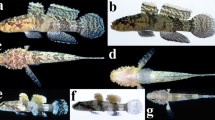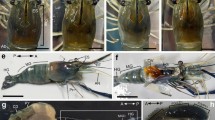Summary
The flame cell of the fish tapeworm (Diphyllobothrium latum) is investigated. In cross-section the flagella originating from the flame cell are hexagonal, except the incomplete ones facing the tubular wall. The function, as regards this unusual structure, is discussed. The axial filament complexes in one flame cell are arranged in opposite directions to each other. Thus the flame cell flagella seem to show many deviating characteristics as compared with those hitherto described.
Similar content being viewed by others
References
Afzelius, A. B.: Electron microscopy of the sperm tail. Results obtained with a new fixative. J. biophys. biochem. Cytol. 5, 269–278 (1959).
—: The fine structure of the cilia from Ctenophore swimming-plates. J. biophys. biochem. Cytol. 9, 383–394 (1961).
André, J.: Sur quelques détails nouvellement connus de l'ultrastructure des organites vibratiles. J. Ultrastruct. Res. 5, 86–108 (1961).
Bawa, S. R.: Electron microscope study of spermiogenesis in a fire-brat insect, Thermobia domestica (Pack). I. Mature spermatozoon. J. Cell Biol. 23, 431–446 (1964).
Bonsdorff, C.-H. v., and A. Telkkä: The spermatozoon flagella in Diphyllobothrium latum (fish tapeworm). Z. Zellforsch. 66, 643–648 (1965).
Bradfield, J. R. G.: Fibre patterns in animal flagella and cilia. Symp. Soc. exp. Biol. 9, 115–127 (1955).
De-Thé, G.: Cytoplasmic microtubules in different animal cells. J. Cell Biol. 23, 265–275 (1964).
Erskine, C. A.: Resistance to deformation of axial structures in living guinea-pig spermatozoa. Science 130, 1188 (1959).
Fawcett, D. W.: Cilia and flagella. In: The cell (J. Brächet and A. E. Mirsky, ed.), vol. 2, p. 217–297. New York: Academic Press 1961.
—: Sperm tail structure in relation to the mechanism of movement. In: Spermatozoon motility (D. W. Bishop, ed.). Washington, D. C.: Amer. Ass. Advanc. of Sci. 1962.
—: The anatomy of the mammalian spermatozoon with particular reference to the guinea pig. Z. Zellforsch. 67, 279–296 (1965).
Kümmel, G.: Das Terminalorgan der Protonephridien, Feinstruktur und Deutung der Funktion. Z. Naturforsch. 136, 676–679 (1958).
—, und J. Brandenburg: Die Reusengeißelzellen (Cortocyten). Z. Naturforsch. 16b, 692–697 (1961).
Ledbetter, M. C. and K. R. Porter: A “microtubule” in plant cell fine structure. J. Cell Biol. 19, 239–250 (1963).
Luft, J. H.: Improvements in epoxy resin embedding method. J. biophys. biochem. Cytol. 9, 409–414 (1961).
Martin, A. W.: Recent advances in invertebrate physiology. A symposium. In: Recent advances in knowledge of invertebrate renal function (B. T. Scheer, ed.). Eugene: Univ. of Oregon publ. 1957.
Pedersen, K. J.: Some observations on the fine structure of planarian protonephridia and gastrodermal phagocytes. Z. Zellforsch. 53, 609–628 (1961).
Race, G. J., J. E. Larsh, jr., G. W. Esch, and J. H. Martin: A study of the larval stage of Multiceps serialis by electron microscopy. J. Parasit. 51, 364–369 (1965).
Reese, T. S.: Olfactory cilia in the frog. J. Cell Biol. 25, 209–230 (1965).
Reynolds, E. S.: The use of lead citrate at high pH as an electron-opaque stain in electron microscopy. J. Cell Biol. 17, 208–212 (1963).
Rothschild, Lord: Sperm movement. Problems and observations. In: Spermatozoon motility (D. W. Bishop, ed.). Washington, D. C.: Amer. Ass. Advanc. of Sci. 1962.
Sabatini, D. D., K. Bensch, and R. J. Barrnett: Cytochemistry and electron microscopy. The preservation of cellular ultrastructure and the enzymatic activity by aldehyde fixation. J. Cell Biol. 17, 19–58 (1963).
Satir, P.: On the evolutionary stability of the 9+2 pattern. J. Cell Biol. 12, 181–184 (1962).
Senft, A. W., D. E. Philpott, and A. H. Pelofsky: Electron microscope observations of the integument, flame cells and gut of Schistosoma mansoni. J. Parasit. 47, 217–221 (1961).
Sleigh, M. A.: The biology of cilia and flagella. New York: Pergamon Press 1962.
Watson, M. L.: Staining of tissue sections for electron microscopy with heavy metals. J. biophys. biochem. Cytol. 4, 475–478 (1958).
Yasuzumi, G., and C. Oura: Spermatogenesis in animals as revealed by electron microscopy. XV. The fine structure of the middle piece in the developing spermatid of the silkworm, Bombyx mori Linné. Z. Zellforsch. 67, 502–520 (1965).
Author information
Authors and Affiliations
Additional information
This investigation is supported by Oskar Öflunds Stifteise.
It is a pleasure to acknowledge the skilful technical assistance of Miss Tellervo Huima.
Rights and permissions
About this article
Cite this article
von Bonsdorff, C.H., Telkkä, A. The flagellar structure of the flame cell in fish tapeworm (Diphyllobothrium latum). Zeitschrift für Zellforschung 70, 169–179 (1966). https://doi.org/10.1007/BF00335671
Received:
Issue Date:
DOI: https://doi.org/10.1007/BF00335671




